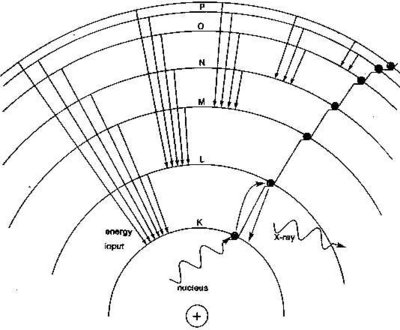by alter-ego » Wed Apr 24, 2013 4:28 am
MargaritaMc wrote:alter-ego wrote:This might be redundant, but I didn't see specific wavelength / energy clearly listed. To add some detail to the
the above image link, I believe that red, green, and blue correspond to 0.5-0.8 keV
(mostly, K lines of O), 0.8-2.0 keV (mostly, K lines of Ne, Mg, and Si), and 2.0-5.0 keV (mostly, synchrotron emission) bands. The middle-range wavelengths (in angstroms 1Å = 10
-10 meters) for these X-Ray energies are 19Å (
red), 8.9Å (
green), and 3.5Å (
blue).
Never having heard of
K lines , I did a search and found this:
K-line (spectrometry)
The K-line is a spectral peak in astronomical spectrometry used, along with the L-line, to observe and describe the light spectrum stars.
The
K-line is associated with iron (Fe), and is described as being
from emissions at ~6.14keV (thousands of electron volts).
http://en.m.wikipedia.org/wiki/K-line_(spectrometry)
I am confused.
Well,
MORE confused...

Margarita
Hi Margarita,
I'll try to simplify the perspective of the K-lines.
I think you know that atoms (elements) consist of nuclei "orbited" by electrons. Quantum physics describes these orbits (really energy levels) as having discrete values. If enough energy is transferred to an electron at one energy level, it will "jump" to another allowed level. When the excitation energy is high enough the electron is freed, and the atom is ionized. In the simple case, when an electron moves to another level, it (or another one) at that level jumps back to re-fill the empty energy level. When this happens energy is given off as electromagnetic radiation.

- X-Ray transition levels
The graphic shows the allowed energy levels as orbital radii from the nucleus where the innermost orbital is known as the K-shell, then L-shell, etc. Note the arrows all point inward, and there is a set of "transition" arrows for each shell. Each arrow represents an electron jump to that orbital, and the longer the arrow, the higher the energy that's released during that transition. All transitions ending on a specific shell are given the name of that shell. So you can see set of longer arrows belong to the "K-lines", and consequently these lines generate the highest transition energies (X-rays). Now you can see that every element has a different set of shells, and therefore most elements have a set of K-lines (remember the energy levels we're discussing here are X-rays, not their lower-energy (visible) siblings.
I think this should help you understand K-lines. As a start, see:
http://en.wikipedia.org/wiki/K-alpha
Of course, SN1006 is a very high-energy environment. X-rays are only part of the energy spectrum.
Hope this helps

[quote="MargaritaMc"][quote="alter-ego"]This might be redundant, but I didn't see specific wavelength / energy clearly listed. To add some detail to the [url=http://chandra.harvard.edu/photo/2013/sn1006/]the above image[/url] link, I believe that red, green, and blue correspond to 0.5-0.8 keV [b](mostly, K lines of O), 0.8-2.0 keV (mostly, K lines of Ne, Mg, and Si), and 2.0-5.0 keV (mostly, synchrotron emission) bands.[/b] The middle-range wavelengths (in angstroms 1Å = 10[sup]-10[/sup] meters) for these X-Ray energies are 19Å ([color=#BF0000]red[/color]), 8.9Å ( [color=#008000]green[/color]), and 3.5Å ([color=#0000FF]blue[/color]).[/quote]
Never having heard of [b] K lines [/b], I did a search and found this:
[quote][b]K-line (spectrometry)[/b]
The K-line is a spectral peak in astronomical spectrometry used, along with the L-line, to observe and describe the light spectrum stars.
The [b]K-line is associated with iron (Fe),[/b] and is described as being[b] from emissions at ~6.14keV[/b] (thousands of electron volts).
[url]http://en.m.wikipedia.org/wiki/K-line_(spectrometry)[/url][/quote]
I am confused.
Well, [i] MORE [/i] confused... :roll:
Margarita[/quote]
Hi Margarita,
I'll try to simplify the perspective of the K-lines.
I think you know that atoms (elements) consist of nuclei "orbited" by electrons. Quantum physics describes these orbits (really energy levels) as having discrete values. If enough energy is transferred to an electron at one energy level, it will "jump" to another allowed level. When the excitation energy is high enough the electron is freed, and the atom is ionized. In the simple case, when an electron moves to another level, it (or another one) at that level jumps back to re-fill the empty energy level. When this happens energy is given off as electromagnetic radiation.
[float=left][attachment=0]x-ray-emission.jpg[/attachment][/float]The graphic shows the allowed energy levels as orbital radii from the nucleus where the innermost orbital is known as the K-shell, then L-shell, etc. Note the arrows all point inward, and there is a set of "transition" arrows for each shell. Each arrow represents an electron jump to that orbital, and the longer the arrow, the higher the energy that's released during that transition. All transitions ending on a specific shell are given the name of that shell. So you can see set of longer arrows belong to the "K-lines", and consequently these lines generate the highest transition energies (X-rays). Now you can see that every element has a different set of shells, and therefore most elements have a set of K-lines (remember the energy levels we're discussing here are X-rays, not their lower-energy (visible) siblings.
I think this should help you understand K-lines. As a start, see: [url]http://en.wikipedia.org/wiki/K-alpha[/url]
Of course, SN1006 is a very high-energy environment. X-rays are only part of the energy spectrum.
Hope this helps :)